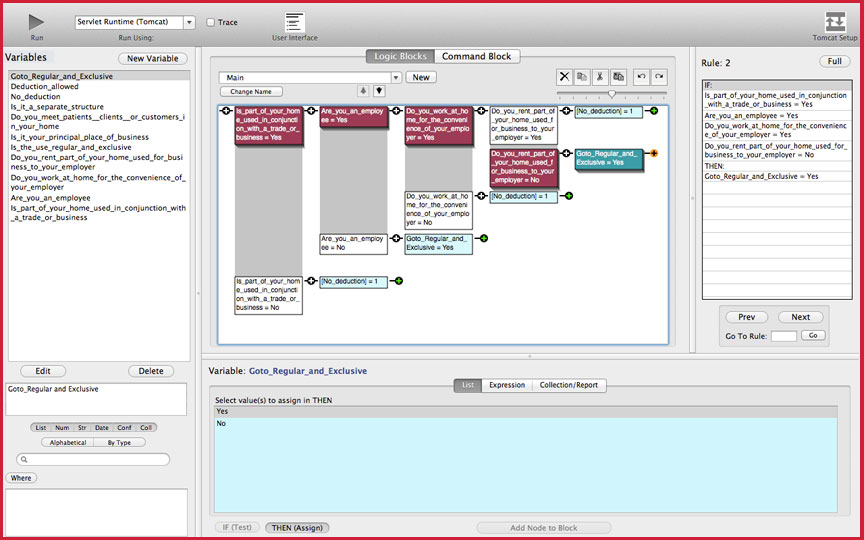 |
|||
 |
|||



 |
|||
|
|
Exsys Corvid Core Overview New Mac OSX app based on Corvid to capture problem-solving knowledge and build online decision support expert systems New to Expert Systems? Exsys Corvid Core is a simplified version of the widely used, high end Exsys Corvid expert system development tool for MS Windows, but designed specifically for Mac OSX. Expert systems are programs that solve decision making tasks by interacting with an end user in a way that emulates the conversation they would have with a human expert to get the advice and assistance they need. Corvid systems do this online via a web browser. Expert systems ask precise, focused, relevant questions based on the user’s input and the system logic, to produce precise, situation specific advice. Complex decision making tasks often require expert knowledge that may have taken the expert years to acquire. In practice, when someone needs to know “How do I fix this?”, “Does this regulation apply to me?”, “What is the best product for me to buy?”, “What should I do?”, it takes more than a quick web search - they would really prefer be able to talk to someone that they know is an expert and get their advice. But experts are usually scarce, expensive resources that are not always available. These days no one can be an expert in everything. Too many complex things break, too many regulations and procedures need to be followed and in many cases there are just too many options. Expert systems can provide the ideal solution in many cases. They capture human expert knowledge and make it available online to provide the answers end users need. Instead of having to work through often irrelevant search results, users are asked precise questions. Based on their answers, the expert system will eliminate unnecessary questions and focus on questions that drill down in the relevant areas to produce situation specific advice on precisely what to do. Sessions dynamically follow the same series of questions and logic that a human expert uses because they are driven by the same logic and process. What Expert Systems are NOT The description of what expert systems can do often make people jump to the the Hollywood depiction of artificial intelligence and computers that can answer any question on their own. Computers that “think” in any real meaning of the term, do not exist and won't for many years. Even the best natural language interfaces like Siri only handle fairly simple queries and that can be done by a quick search. Exsys Corvid Core does not “know” how to solve problems out of the box. It is a development tool that allows YOU to describe the logic and process that a human expert uses to solve whatever problems you want. Then it converts that logic into files that are fielded online to drive interactive browser-based sessions that interact with the end users to emulate the conversation they would have with the expert.  Corvid Core's Power - Heuristic Rules and the Exsys Inference Engine Corvid Core's Power - Heuristic Rules and the Exsys Inference Engine
Exsys Corvid Core uses IF/THEN logic to describe the steps in a decision making process. Most computer users have run across IF/THEN logic either in a programming language or an application that does something based on a test expression. The rules in Exsys Corvid Core, while superficially similar to IF/THEN statements in programming languages are fundamentally very different. In a traditional programming language, if one IF/THEN test is dependent on another IF/THEN test, they must be explicitly linked together in the code - either by nesting the tests or by having code to make sure they are executed in the correct order. As the number of tests (rules) gets large there are many interrelationships, and hard coding these explicit links becomes very difficult to understand, code and maintain. Small changes in one rule can have major (and sometimes undesired) changes in other sections. Add in probabilistic logic, and it gets even worse. This is why hard coding anything more complex than very simple logic becomes extremely difficult to code/maintain, and hard coding real-world systems that fully incorporate the many factors experts use to make complex decisions is rarely done. Exsys Corvid Core uses a very different approach with heuristic rules processed by an Inference Engine. “Heuristic rules” are often simply defined as “rules of thumb”, like the individual rules the human expert uses to make a decision. A simple way to get the heuristic rules of a decision is to ask an expert that has provided some advice, “How did you come to that conclusion?” They will probably respond with something like “Since I saw X and Y, I knew Z”. For example, “Since the temperature was too high and the warning light was blinking, I know it is usually a problem with the controller”. This may be a high level rule, and you might need to ask about the details. For exampled, “Well, how did you determine the temperature was too high?” This would lead to another heuristic rule on that detail, such as “Since you were working on material A, that should be kept less than 150 degrees, but for material B, it would be OK up to 180 degrees.” Each of these statements, while not structured in an IF/THEN form can be converted to an IF/THEN rule in Corvid Core: IF: IF: IF: These rules contain the same knowledge as the expert’s statements, but are now in a form that is easy for humans to read and understand, and can be processed and used by the Exsys Corvid Core Inference Engine to capture and automate the decision process. The Exsys Inference Engine is able to use the human readable rules in an effective way online without converting them to “computer code”. When the Inference Engine is told to determine the cause of the problem, it will find the rule(s) that can tell it - here it's the first rule that says the “problem is the controller” rule. Since this rule is relevant to determining the cause of the problem, the Inference Engine automatically “knows” to use it and tests to see if the rule can be used. Testing the IF conditions in the rule requires determining if the “Temperature is too high”. Instead of having to explicitly hard code links to the rules that are needed to provide this information, the Inference Engine automatically looks through the rules to find any that might be relevant to determining this fact. It will find the rules that would allow it to derive that the “Temperature is too high”. It now tests those rules to get information that can be used in earlier rules that were initially tested. This is called “Backward Chaining” and can be repeated as many levels deep as needed. All the linkages between rules are dynamic and implicit, so there's no need to hard code links between rules. The Inference Engine automatically uses all appropriate rules when, and if, they are needed. Rules can be anywhere in a system and structured however the expert prefers. If an individual rule changes, it can be modified and the effects will automatically be applied throughout the system anywhere that rule is relevant. Instead of a programmer converting decision making steps into computer code, the expert can create the rules themselves. Each rule is human readable, but still can be used by the computer. Exsys Corvid Core is designed to allow non-programmers to build systems incorporating even very complex logic. Systems are built by simply describing the various IF/THEN heuristic rules that are used in making a decision. These rules are written in simple English (or whatever language you prefer) and algebra syntax that is easy to read and understand. In most systems, the order of the rules does not matter as long as they are all there. Building a system in Exsys Corvid Core is like explaining the steps in a decision making task to another person. Generally, the best way to start building a system is to think “how would I teach someone to make this decision”. Exsys Corvid Core rules are built in Corvid’s unique “Logic Blocks” which make it easy structure sets of rules that cover all the possible decision-making cases. The Exsys Inference Engine then uses the rules to determine:
When running the system, the end user will be asked to provide input whenever the logic needs information, and it cannot be derived from other rules. If the information is not required, it will not be asked - no irrelevant questions. But, all relevant rules will be used, so all logic that might apply to the decision will always be used - infrequently used, special cases will not be overlooked. To ask the user for input, the Inference Engine displays a question in their browser window. The developer can format how questions will be asked to match a site’s look and feel. Exsys Corvid Core supports both Java applet and Java servlet versions of the powerful and proven Exsys Inference Engine as Runtime programs. The applet runtime runs on the end users machine as a Java applet in their browser window making it very easy to field systems online. The servlet version runs on a server, with question and result screens designed using HTML. Since the servlet runtime only sends HTML to the end user, it provides compatibility with all browsers, along with allowing systems to be run on iPhones, iPads and other browsers that do not support Java. The Servlet Runtime user interface is designed using HTML templates files. The default templates automatically convert the colors, fonts, layout, styles, images, etc. set in Corvid Core into CSS and HTML, making it easy to field systems with the look you want. For even more control, the default templates can be replaced by customized templates using any HTML, CSS, HTML5, etc. for complex interactive user interfaces. The Corvid Core development environment includes and installs Apache Tomcat making it easy to fully build and test systems on a "localhost" server. Corvid automatically builds the logic files and provides easily editable HTML templates that control the end user interface. Both the included Exsys Applet and Servlet Runtimes can be used to field the systems you build. Corvid vs Corvid Core For many years the high-end Exsys development tool has been Exsys Corvid. It is very robust and powerful and currently only runs in MS Windows. Priced at just under $10,000, it is a tool primarily focused toward large companies, government agencies and military projects. Despite its price, Corvid is very popular, with Corvid systems typically getting ROIs of 10 to 1, and sometimes even 100 to 1. Exsys Corvid Core is a functional subset of Exsys Corvid. It does not support some of the more advanced expert system features of Corvid, but provides the core functionality needed to handle many expert system problems. Exsys Corvid Core uses the same proven powerful Exsys Inference Engine and development methodology as Corvid, with Variables, Logic Blocks and Command Blocks, with a new completely redesigned Mac development environment. Click to see the Corvid vs Corvid Core Feature Comparison. Systems built with Exsys Corvid Core are not compatible with the MS Windows version of Exsys Corvid, and visa versa. The 2 programs use a different file structure and are limited to the program that created them. Exsys Corvid Core was designed from scratch for the Mac with an OSX style approach using new single window interface. The underlying capabilities of OSX made it possible to implement some new development features not found even in Corvid. Exsys Corvid Core is also full integrated with the Exsys Servlet Runtime and Apache Tomcat, making it far easier to build and test systems using the servlet version of the Exsys Inference Engine. So why is Exsys Corvid Core so much lower priced than Corvid? Corvid is a very powerful development system, and for advanced complex expert systems its still the tool to use. But many systems don’t need the full power of Corvid - and realistically, many groups don’t have the budget for it. The Web is how everyone distributes knowledge, and a huge number of information-oriented web sites are trying to provide advice to end users that could be better done with expert systems. Exsys Corvid Core provides the power that is needed at a low cost. Exsys’s first development tools cost only a few hundred dollars many years ago. Their price went up with their power, functionality and a focus on specialized markets. Exsys Corvid Core returns to that low price point since the web now makes expert system development and deployment the ideal solution for many sites. Exsys has also long supported the academic community with low cost and free (limited) versions of Exsys Corvid. There have been many requests for a Mac version. Corvid Core is an ideal option. Its low price (especially with Apple's academic discounts) makes it a lower cost than many textbooks. To see how easy it is to build systems with Exsys Corvid Code take a look at the online tutorials. The 2 Quick Start tutorials will show you all you need to be building systems in less than an hour. Who is Exsys Inc? For over 30 years, Exsys Inc has been in the expert system development software and services business. Exsys tools have been used to build tens of thousands of expert systems in business, industry, government and military. Exsys systems have been used for a vast range of complex problems including diagnosing jet aircraft, defending naval ships, keeping Fortune 100 companies productive, and implementing complex regulations. A quick look at some of the case studies on the Exsys web site shows the wide range of uses for Exsys systems - and those are only a small sample. Exsys has focused on designing tools that are easy to use and practical. Exsys tools make it easy for developers to build and field systems that still handle very complex decision making tasks. Exsys has extensive proven experience in working with companies on what is needed to describe complex logic in way that is easy for non-programmers to learn, with a very pragmatic approach to building expert systems. The Java based Inference Engine runtime programs are extensively proven over a wide range of problem types. System Requirements Exsys Corvid Core is available ONLY for Mac OSX and available only from the Apple App Store. Exsys Corvid Core will run on any Mac running OSX 10.9 and higher.
|
||
 |
 |
||



